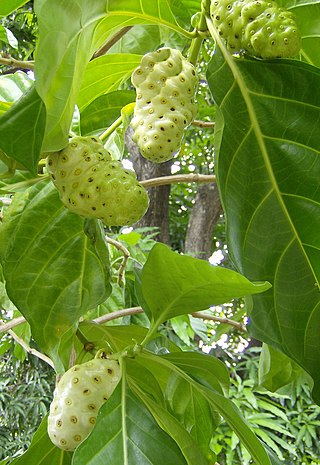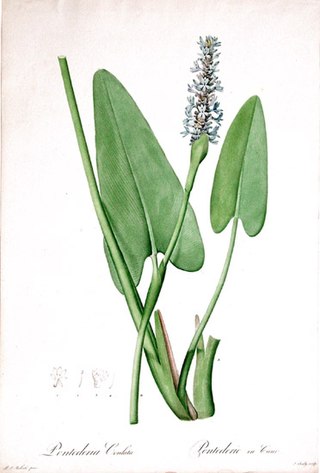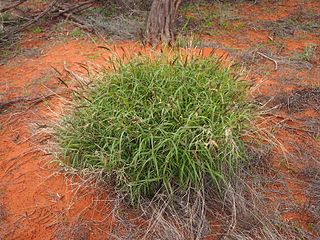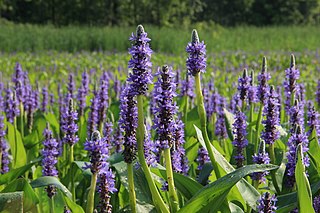
Sorghum or broomcorn is a genus of about 25 species of flowering plants in the grass family (Poaceae). Sorghum bicolor is grown as a cereals for human consumption and as animal fodder.

Lygodium is a genus of about 40 species of ferns, native to tropical regions across the world, with a few temperate species in eastern Asia and eastern North America. It is the sole genus in the family Lygodiaceae in the Pteridophyte Phylogeny Group classification of 2016. Alternatively, the genus may be placed as the only genus in the subfamily Lygodioideae of a more broadly defined family Schizaeaceae, the family placement used in Plants of the World Online as of November 2019. Per recent molecular evidence, Lygodiaceae is thought to have diverged relatively early from the other members of the Schizaeales due to the relatively high level of synonymous sequence divergence between the families within the Schizaeales.

Casuarina equisetifolia, commonly known as coastal she-oak, horsetail she-oak, ironwood,beach sheoak, beach casuarina or whistling tree is a species of flowering plant in the family Casuarinaceae and is native to Australia, New Guinea, Southeast Asia and India. It is a small to medium-sized, monoecious tree with scaly or furrowed bark on older specimens, drooping branchlets, the leaves reduced to scales in whorls of 7 or 8, the fruit 10–24 mm (0.4–0.9 in) long containing winged seeds (samaras) 6–8 mm (0.2–0.3 in) long.

Morinda citrifolia is a fruit-bearing tree in the coffee family, Rubiaceae, native to Southeast Asia and Australasia, which was spread across the Pacific by Polynesian sailors. The species is now cultivated throughout the tropics and widely naturalised. There are over 100 names for this fruit across different regions, including great morinda, Indian mulberry, noni, beach mulberry, vomit fruit, awl tree, and rotten cheese fruit.

Santalum is a genus of woody flowering plants in the Santalaceae family, the best known and commercially valuable of which is the Indian sandalwood tree, S. album. Members of the genus are trees or shrubs. Most are root parasites which photosynthesize their own food, but tap the roots of other species for water and inorganic nutrients. Several species, most notably S. album, produce highly aromatic wood, used for scents and perfumes and for herbal medicine. About 25 known species range across the Indomalayan, Australasian, and Oceanian realms, from India through Malesia to the Pacific Islands, as far as Hawaiʻi and the Juan Fernández Islands off the coast of South America.

Pontederia is a genus of tristylous aquatic plants, members of which are commonly known as pickerel weeds. Pontederia is endemic to the Americas, distributed from Canada to Argentina, where it is found in shallow water or on mud. The genus was named by Linnaeus in honour of the Italian botanist Giulio Pontedera.

Hibiscus tiliaceus, commonly known as the sea hibiscus or coast cottonwood, is a species of flowering tree in the mallow family, Malvaceae, with a pantropical distribution along coastlines. It has also been introduced to Florida and New Zealand. It has been debated whether this species is native or introduced to Hawaii.

Calotropis procera is a species of flowering plant in the family Apocynaceae that is native to Northern and Tropical Africa, Western Asia, South Asia and Indochina. It typically reaches a height between 6 feet (1.8 m) to 8 feet (2.4 m), and rarely to as high as 15 feet (4.6 m), and grows in sunny to partly-shaded habitats such as disturbed and overgrazed lands, rangeland, roadsides, river flats and coastal dunes. Its green fruits contain a toxic milky sap that is extremely bitter and turns into a latex-like substance, which is resistant to soap.

Panicum (panicgrass) is a large genus of about 450 species of Poaceae grasses native throughout the tropical regions of the world, with a few species extending into the northern temperate zone. They are often large, annual or perennial grasses, growing to 1–3 m (3–10 ft) tall.

Cenchrus ciliaris is a species of grass native to most of Africa, southern Asia, southern Iran, and the extreme south of Europe (Sicily). Other names by which this grass is known include dhaman grass, anjan grass, koluk katai and buffelgrass.

The Indian spotted eagle is a large bird of prey native to South Asia. Like all typical eagles, it belongs to the family Accipitridae. The typical eagles are often united with the buteos, sea eagles and other more heavyset Accipitridae, but more recently it appears as if they are less distinct from the more slender accipitrine hawks.

Murraya paniculata, commonly known as orange jasmine, orange jessamine, china box or mock orange, is a species of shrub or small tree in the family Rutaceae and is native to South Asia, Southeast Asia and Australia. It has smooth bark, pinnate leaves with up to seven egg-shaped to elliptical leaflets, fragrant white or cream-coloured flowers and oval, orange-red berries containing hairy seeds.

Pontederia cordata, common name pickerelweed (USA) or pickerel weed (UK), is a monocotyledonous aquatic plant native to the Americas. It grows in a variety of wetlands, including pond and lake margins across an extremely large range from eastern Canada south to Argentina. A few examples include northern rivers, the Everglades and Louisiana.
Stemona australiana is a plant species native to tropical south-east Asia, including northern Australia and Papua New Guinea. It grows as a herb or climber up to two metres high.

Eclipta is a genus of flowering plants in the family Asteraceae.
Kapok fibre is a cotton-like plant fibre obtained from the seed pods of a number of trees in the Malvaceae family, which is used for stuffing mattresses and pillows, for padding and cushioning, and as insulation.

Melastoma malabathricum, known also as Malabar melastome, Indian rhododendron, Singapore rhododendron, planter's rhododendron and senduduk, is a flowering plant in the family Melastomataceae native to Seychelles, tropical and subtropical Asia to Australia and western Pacific islands. Despite its common names, it does not have any connection to actual rhododendrons, and belongs to the Rosids clade as opposed to the Asterids clade. This plant is usually found at elevations between 100 m and 2,800 m in grassland and sparse forest habitats. It has been used as a medicinal plant in certain parts of the world, but has been declared a noxious weed in the United States. M. malabathricum is a known hyperaccumulator of aluminium, and as such can be used for phytoremediation.

Pavonia hastata, commonly known as spearleaf swampmallow or pink pavonia, is a shrub in the family Malvaceae. The species is native to Brazil, Bolivia, Argentina, Paraguay and Uruguay. It was previously considered to be native to Australia as well, but is no longer thought to be.

Monochoria was originally a genus of aquatic plants in the water hyacinth family, Pontederiaceae. Currently, it has been reduced to a subgenus of Pontederia, Pontederia subg. Monochoria, represented by ten species. Its species are native to tropical and subtropical Africa, Asia, and Oceania. They live in the water or in wet soils. They produce leaves on long petioles and some are cultivated for their attractive flowers. Plants from this species have been utilized in the creation of traditional herbal treatments, food, and cosmetics for a very long time.

Grona is a genus in the flowering plant family Fabaceae. Its native range is worldwide tropics and subtropics.


















